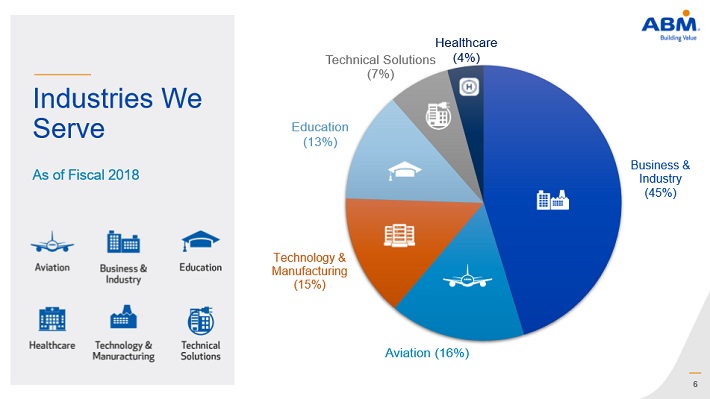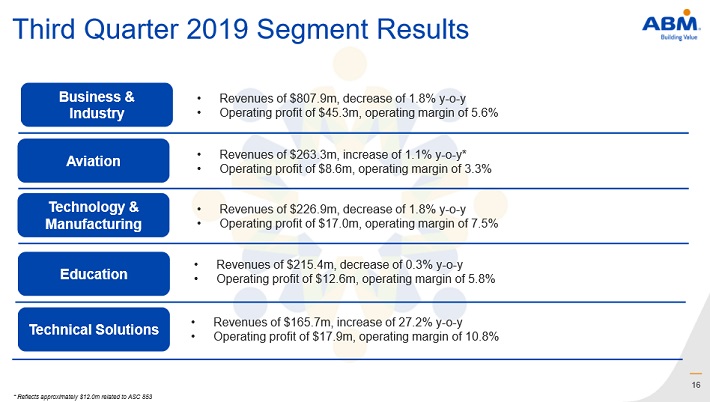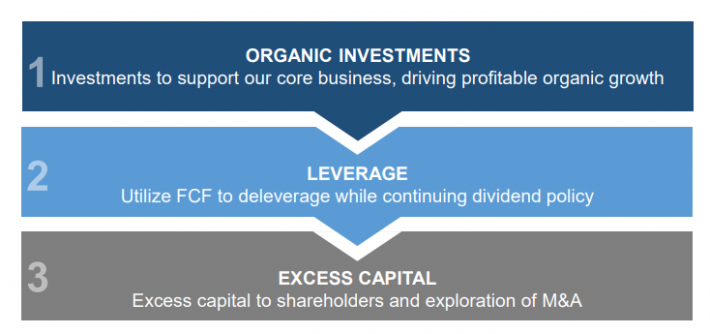Updated on December 12th, 2019 by Bob Ciura
ABM Industries (ABM) has an amazing track record when it comes to paying dividends to shareholders. ABM is part of the Dividend Kings, a group of stocks that have raised their payouts for at least 50 consecutive years. You can see all 27 Dividend Kings here.
Click here to download my Dividend Kings Excel Spreadsheet now. Keep reading this article to learn more.
Dividend Kings are the best of the best when it comes to rewarding shareholders with cash and this article will discuss ABM’s dividend, as well as its valuation and outlook. You can also watch a detailed analysis of ABM’s dividend safety in the following video:
Business Overview
ABM was founded back in 1909 and since that time, it has grown into an industry powerhouse. ABM Industries is a leading provider of facility solutions, which includes janitorial, electrical & lighting, energy solutions, facilities engineering, HVAC & mechanical, landscape & turf, and parking. The company employs more than 130,000 people in more than 350 offices throughout the United States and various international locations, primarily in Canada.
ABM counts hospitals, universities, public schools, data centers, manufacturing plants, airports and others among its long and impressive client list.
Source: Investor Presentation
The company’s expertise and many decades of experience in facility management has earned it a terrific reputation and it is a true industry leader. ABM Industries is headquartered in New York, NY, and is currently trading with a market capitalization of $2.5 billion.
ABM Industries reported its third quarter earnings results (fiscal 2019) on September 5th. The company announced that its revenues totaled $1.65 billion during the quarter, which was in line with analyst estimates, and which represents a growth rate of 1.9% versus the prior year’s quarter. Unlike in previous quarters, acquisitions did not have a meaningful positive impact on ABM Industries’ revenue growth rate during Q3. The company’s organic revenue growth rate, which backs out currency movements, was 2.3% during the quarter. Results were slightly hurt by a strong U.S. Dollar that weakened its non-US revenues when translated to USD.
Performance by operating segment can be seen in the following image:
Source: Earnings Presentation
ABM Industries generated earnings-per-share of $0.60 during the third quarter, which beat the analyst consensus estimate by $0.02, but did not represent a meaningful improvement over the third quarter of the previous fiscal year. Adjusted EBITDA was up slightly versus the previous year’s quarter, growing to $93 million.
ABM Industries guides for EBITDA margins of ~5.2% for fiscal 2019. It also forecasts earnings-per-share in a range of $1.95 to $2.05, which represents a mid-single-digit growth rate versus 2018’s earnings-per-share of $1.89.
ABM’s strategy is to compete in industries where it can win and that selection of customer bases is what you see above; ABM has learned through the decades where it can compete successfully and where it cannot and has focused its efforts accordingly.
ABM is a serial acquirer and the below image shows recent acquisitions and divestitures that have molded ABM into what it is today.
Source: Investor day presentation, page 8
In 2007 ABM’s revenue was about $3B and today, it is more than double that amount. ABM has grown some organically but the vast majority of its growth has been purchased. And given strategic direction from ABM in terms of future cash usage, we can expect more acquisitions as the years go on.
One source of potential growth going forward is international expansion as ABM entered the U.K. market with the GBM and Westway acquisitions in the past few years. Going forward, continue to look for lots of transactions from ABM in terms of both acquisitions and divestitures as it shifts its mix around further.
ABM is split into six segments that provide a wide array of facility solutions to its customers: Business & Industry, Education, Aviation, Technology & Manufacturing, Healthcare, and Technical Solutions. The company’s revenue streams are highly diversified and as I mentioned, janitorial services are the biggest single piece of the pie for ABM.
Growth Prospects
ABM’s stated strategy is to grow by acquisition, as we saw above. That’s not to say that it is ignoring its ability to grow organically, however, as this slide from a recent investor presentation shows.
Source: Investor day presentation, page 58
Essentially ABM is saying that when it has free cash flow to spend, it looks first at organic growth. The company has deep expertise and a great reputation here in the US for facilities management and looks to exploit that where possible. That means going after national accounts first where it can gain a significant amount of business all at once as well as centralizing support services to improve margins.
ABM also specifically calls out acquisitions in its strategy, although it is behind organic investments and the dividend. Still, ABM’s recent history suggests that acquisitions are a very important part of its overall strategy and thus, we can expect ABM will continue to grow via acquisitions as well as organically.
ABM is still extremely focused on the US market and that presents potential opportunities for further international expansion. However, ABM could use its significant expertise in facilities management to gain access to global clients around the world. The moves into the U.K. in recent years prove ABM is willing to take a chance and this may be the most significant growth avenue ABM has going forward. Keep in mind that the process to diversify away from the US has been slow thus far, but it is certainly worthy of investors keeping it on their radar.
ABM will continue to grow revenue in the coming years but if it goes some time without a major acquisition, look for total revenue growth in the low single digits.
A concern for ABM going forward is its margin profile. Adjusted EBITDA margin is expected to come in at 5.2% for the fiscal year, although this does represent a significant expansion from just 4.1% in the first quarter of the fiscal year. Still, the businesses ABM competes in are high-volume but carry thin margins. ABM is providing what amounts to low-cost labor for its clients in most of its businesses, meaning barriers to entry are low for any particular account, especially at the local level.
ABM’s advantage, however, is in the scale it provides and it is focused at the senior management level on finding and eliminating redundancies. Thus, margin growth is a potential avenue for earnings growth in the coming years as those efforts bear fruit, as they did over the course of the current fiscal year. Overall, however, ABM’s growth is likely to be moderate given the structural headwinds to revenue and margin growth in the businesses it competes in. We expect 6% annual earnings-per-share growth over the next five years.
Competitive Advantages & Recession Performance
ABM’s competitive advantage is its size and scale. It has a 100+ year history of providing facility solutions for a wide array of customers and that expertise is what sets ABM apart. It is a true industry leader in the facilities management space and that affords it not only the ability to more easily attract new clients, but also to expand relationships with ones it already has.
In addition, since ABM operates in low-margin businesses, smaller competitors are at a disadvantage in terms of leveraging down back office and support costs. ABM may be in some competitive lines of work but it is certainly better positioned than its competitors to overcome some of those obstacles. ABM Industries is one of the biggest companies in its industry, and its history of making acquisitions has enhanced its scale advantages further. It is likely that ABM Industries will continue to make acquisitions to increase its size further
Recessions are painful for ABM just like any other company, but its performance during the Great Recession was remarkable. ABM’s earnings-per-share during the Great Recession are below:
- 2007 earnings-per-share of $0.99
- 2008 earnings-per-share of $1.10 (11% increase)
- 2009 earnings-per-share of $1.33 (21% increase)
- 2010 earnings-per-share of $1.34 (0.7% increase)
ABM’s total revenue was higher in 2008 than it was in 2007 despite the nasty recession we were experiencing. That is due to the OneSource acquisition in 2007 as those results were added to the company’s top line in 2008, driving it higher. After that, revenue was slightly lower in the next two years as ABM saw a diminutive negative impact to its top line from tough economic conditions.
EPS shows a slightly rosier path during and after the recession. ABM grew earnings-per-share in each year of the Great Recession. Very few companies were able to accomplish this. ABM provides what is essentially a staple service to businesses and thus, it isn’t something that can easily be cut in a recessionary environment. That leads to low margins and low rates of growth but strong recession performances like what we see above. As a result, ABM is a highly recession-resistant business.
Valuation & Expected Returns
According to ValueLine, ABM is expected to generate earnings-per-share of $1.95 for 2018. As a result, the stock trades for a price-to-earnings ratio of 17.7. The stock has held an average price-to-earnings ratio of 17.5 in the past 10 years. We consider 17.5 to be a reasonable estimate of fair value for this stock.
That’s not a cheap valuation for a stock with low margins and low growth prospects, but ABM’s recent acquisitions are providing some upside for revenue and earnings in the near term. Longer-term there are catalysts for earnings growth, including the low single digit rate of organic revenue growth mentioned earlier, as well as the margin improvement efforts ABM has already undertaken.
EBITDA margins in fiscal 2015 were in the mid-3% range while guidance for this year is for EBITDA margin above 5%. That’s a significant amount of margin growth and that is the story for ABM going forward; acquisitions, a small amount of organic growth and the potential for incremental margin growth.
With a current 2019 price-to-earnings ratio of 18.9, ABM stock appears to be slightly overvalued, given our fair value estimate of 17.5. Therefore, a declining valuation multiple could reduce annual shareholder returns by 1.5% per year. Dividends and EPS growth will likely provide a positive return for shareholders, however.
The dividend represents a 2% yield at present, which means ABM is not a high-yield stock, although it does provide a slightly higher yield than the S&P 500 average. In addition, recent dividend increases have been very small with typical increases in the 2% or 3% range. While ABM has an impressive history of paying dividends, it lacks both a high current yield and high rates of payout growth.
That said, at the current valuation, ABM’s total returns could still be strong. EPS growth over the medium term is expected to be 6% per year. Combined with a 2% dividend and the impact of a declining P/E multiple, total annual returns could approach 6.5% per year. This is not a spectacular expected rate of return, but is satisfactory for risk-averse investors seeking a reliable dividend growth stock.
Final Thoughts
ABM is certainly not a high-yield income stock, nor is it a high dividend growth stock. But what it lacks in excitement, it makes up for with consistency. ABM’s long and impressive history of paying a dividend should be respected, as the Dividend Kings are rare in comparison to the thousands of publicly-traded stocks in the market.
ABM’s organic growth is intact, and acquisitions add to growth. Growth from here depends upon potential international expansion as well as continued margin gains.
With a reasonable valuation and growth up ahead, total returns could be fairly attractive from here. ABM is a Dividend King but it is not a stock to buy for a high dividend yield. Instead, it is a slow and steady dividend growth stock with resilient profits in a recession.









